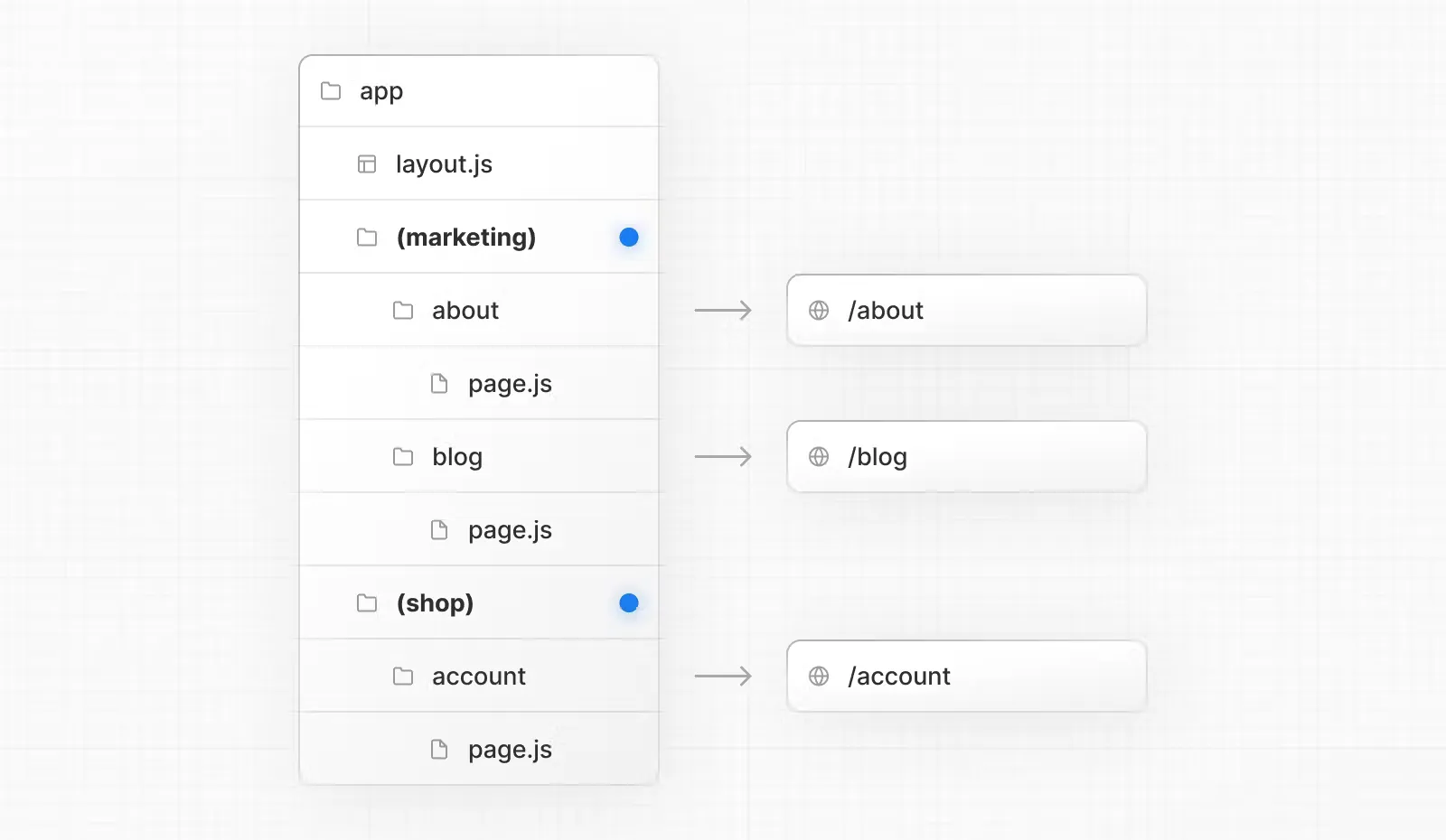Table of contents
Open Table of contents
开始
Next.js 14 推出了新的 App router ,Server component 和 Streaming 等新特性。
App router
Vercel 推出了一个新的路由系统,用于替代原来 Page router,但 Page router 仍然可用。并且可以和 App router 混合使用。

App Router 的顶级路由是 app 目录,下级可创建自己的目录。每个目录下面创建 page.tsx 来定义页面内容。
Route Resolution
export default function Page() {
return <h1>Hello, Dashboard Page!</h1>
}动态路由可以使用 [] 形式来定义,和 Page router 保持一致。例如
// app/blog/[slug]/page.tsx
export default function Page({ params }: { params: { slug: string } }) {
return <div>My Post: {params.slug}</div>
}如果只是想通过文件夹组织代码,而不想体现到路由中,可以使用 Route Group 路由分组,用 () 形式定义目录名。

如果想用 NextJS 同时作为后端服务,可以使用 Route Handlers 来定义 API 路由,使用 Web Request 和 Response API。
export const dynamic = "force-dynamic"; // defaults to auto
export async function GET(request: Request) {
return Response.json({
name: "RealTong",
});
}NextJS 14 还有其他的一些文件约定,这里提供一个详细的表格
| 文件名 | 作用 |
|---|---|
| layout | 用于共享页面布局 |
| page | 定义页面内容 |
| loading | 定义页面 loading 状态 |
| not-found | 404 页面 |
| error | 定义页面错误 |
| global-error | 全局错误处理 |
| route | 定义 API 路由 |
| template | 专门的重新渲染的布局 UI |
| default | 并行路由的 Fallback UI |
Server Component
NextJS 14 版本默认所有的组件都是 Server Component 服务端组件。服务端处理数据会更加安全。服务端可缓存数据、直接渲染 HTML 、还可支持 Streaming 流式渲染,这些方式都会提升性能。
如果有些组件需要用到浏览器的 API ,则需要开发人员手动标记为客户端组件,使用 ‘use client’ 关键字。例如 useEffect 就需要客户端组件,其他常见的还有 useState 、 DOM 事件、路由和 url 操作、表单校验等很多。当一个组件为客户端组件时,在其中引入的所有子组件都必须是客户端组件。
'use client'
import { useEffect } from 'react'
export default function About() {
useEffect(() => {
console.log('done')
}, [])
return <p>About</p>
}关于 Server Component 和 Client Component 的区别,可以简单理解为:
- Server Component 是获取数据,并一次性渲染出结果(构建时,或者运行时),重点在于渲染。
- Client Component 是渲染完成以后,还有其他的交互和更新,重点在于交互。
Streaming 流式渲染
设想一个场景,一个 dashboard 页面,上面有很多模块,例如用户信息、订单信息、商品信息、天气信息等等。当其中的某个模块 API 请求过慢时,整个页面会因为等待而卡顿。造成用户体验不好。 这是就用到了 Streaming 流式渲染。
这在 NextJS 14 中变得容易也非常简单,只需要在路由文件夹中加一个 loading.tsx ,结合 Suspense 组件,就可以实现。
// app/dashboard/loading.tsx
export default function Loading() {
// You can add any UI inside Loading, including a Skeleton.
return <LoadingSkeleton />
}// app/dashboard/page.tsx
import { Suspense } from 'react'
import { PostFeed, Weather } from './Components'
export default function Posts() {
return (
<section>
<Suspense fallback={<p>Loading feed...</p>}>
<PostFeed />
</Suspense>
<Suspense fallback={<p>Loading weather...</p>}>
<Weather />
</Suspense>
</section>
)
}

Fetch & Cache
NextJS 14 引入了非常复杂的缓存机制,用于获取数据和缓存。并且 NextJS 默认情况下会缓存所有获取的数据。
如果使用 fetch 获取数据,可以使用 revalidate 或者 {cache: ‘no-store’} 来设置缓存时间。
fetch("https://...", { next: { revalidate: 3600 } });
fetch("https://...", { cache: "no-store" });还可以这样:使用 noStore() 做标记。
import { unstable_noStore as noStore } from "next/cache";
export async function fetchRevenue() {
// 这相当于 fetch(..., {cache: 'no-store'}).
noStore();
// get and return db data
}
// 如果需要重新验证某个页面的缓存,还可以使用 revalidatePath。
revalidatePath("/dashboard/invoices");Server Action
用 ‘use server’ 标记一个 ts 文件(里面的所有函数),或者一个 ts 函数,则可把他们标记为 Server Action 即在服务端执行的代码,一般用户客户端提交数据。
Server Component 中,可以直接定义一个 async 函数中为 Server Action ,也可以引入一个文件。
// Server Component
export default function Page() {
// Server Action
async function create() {
'use server'
// ...
}
return (
// ...
)
}而 Client Component 只能引入一个 Server Action 文件。或者把 create 函数作为属性,传递给客户端组件。
// app/actions.ts
'use server'
export async function create() {
// ...
}
// app/ui/button.tsx
import { create } from '@/app/actions'
export function Button() {
return (
// ...
)
}Server Action 函数可用于 <form> 或者 DOM 事件、 useEffect 等任何地方。